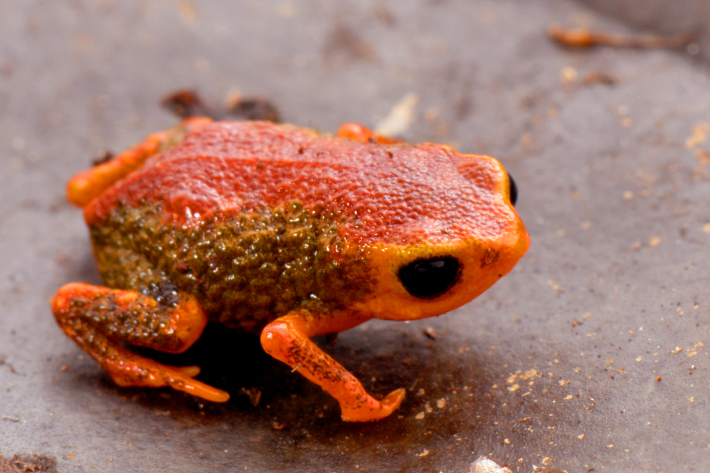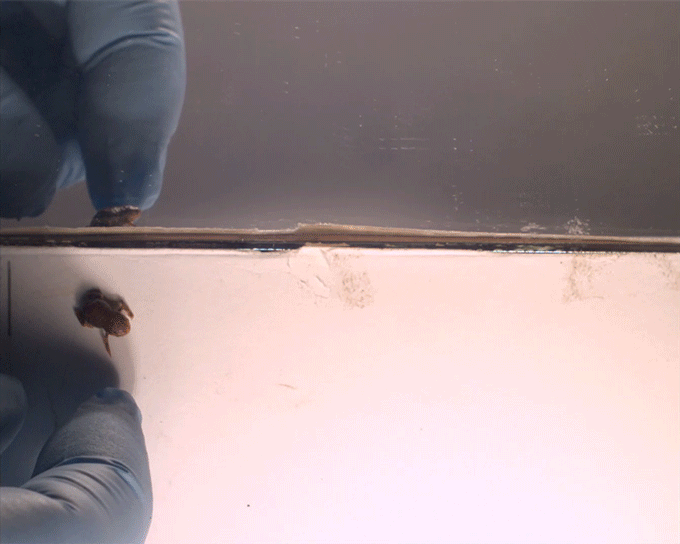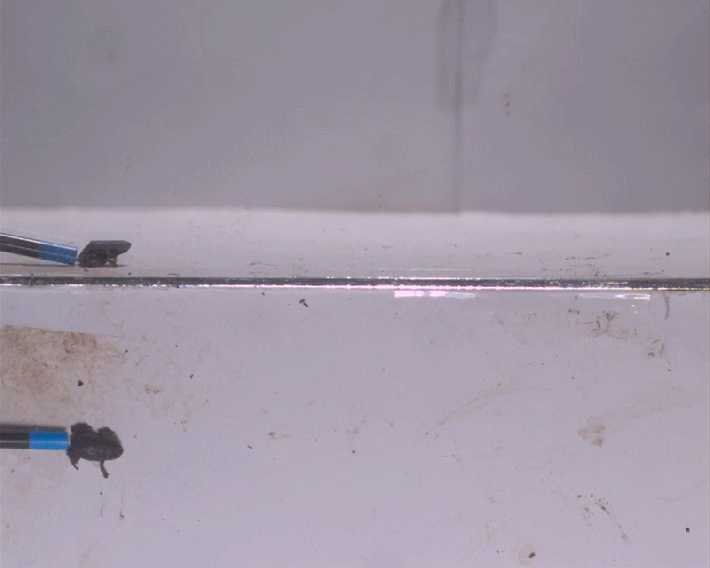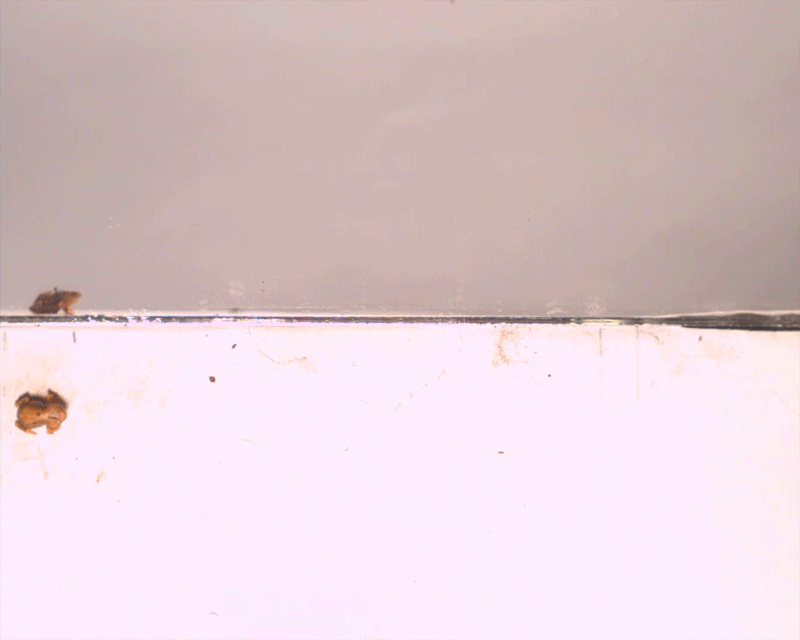The moment the pumpkin toadlet leaps into the air, anything seems possible. The tiny frog, which is about the size of a honeybee and the color of a cloudberry, has no problem launching itself high off the ground. But when the pumpkin toadlet begins to soar, something goes awry.
The frog's body, limbs splayed like a starfish, starts to spin. And then it falls, tumbling gracelessly until it lands on its rear or its head and unintentionally cartwheels or backflips to a stop.
"Some guys are just spinning," said André Confetti, a graduate student at the Federal University of Paraná in Brazil, demonstrating by twirling his finger in the air over a Zoom call. "Some guys do this movement," Confetti added, waving his fingers in circles like a waterwheel.
"Frogs flailing in air, in space," said Amber Singh, who will soon be a master's student at San Jose State University.
The pumpkin toadlet, which is a frog but not a toad, is so terrible at landing its jumps that its sheer incompetence has become a subject of scientific inquiry. A team of researchers from the United States and Brazil that includes Confetti and Singh say they have an answer: The miniaturized toadlets are so tiny that the fluid-filled chambers in their inner ears which control their balance function rather ineffectively, dooming the valiant little jumpers to a lifetime of crash landings.
The paper confirms that many species of pumpkin toadlets, which belong to a genus of tiny frogs called Brachycephalus, present "a very unusual jump with uncontrolled landing behavior," said Thais Condez, a researcher at Carleton University in Canada, who was not involved with the research.
Or, as Confetti put it, "they do nothing correctly."
It is not easy to be a vertebrate the size of a bee. Pumpkin toadlets have made evolutionary trade-offs to be this small, such as reducing the number of digits on their legs from five to three. Frogs, which are famously moist, dry out more quickly when they get this small, said Rick Essner, a functional morphologist at Southern Illinois University Edwardsville and author on the paper. But sometimes it does pay to be tiny: "To a pumpkin toadlet, an ant is a huge meal," Essner said.

Frogs evolved the ability to jump before they evolved the ability to land, meaning not all frogs have mastered the second part of the process. Essner previously researched a group of similarly clumsy tailed frogs, which jumped acceptably enough but landed in a full faceplant.
When Marcio Pie, then a researcher at the Federal University of Paraná in Brazil and an author on the paper, learned of Essner's belly-flopping frog research, he emailed Essner about the pumpkin toadlets. Members of Pie's lab began collecting toadlets and other miniaturized frogs from the wild to watch them jump and (try to) land.
Pumpkin toadlets live elusive lives. The frogs live and forage under fallen leaves in Brazil's Atlantic Forest, which, compounded with their size, make them exceedingly difficult to study. "They are very small and secretive organisms," Condez said. "Most of our knowledge regarding their behavior comes from rare observations in the field."
Finding bug-sized frogs in Brazil is an arduous task. Even though a pumpkin toadlet is as bright as a Cheeto, the leaf litter teems with neon fungi and other orange-colored life. "It is extremely hard to catch underneath the leaf litter," Confetti said. "Especially for me, because I'm colorblind."
Instead, the researchers had to listen for the frog's call, which sounds a bit like a cricket. Back in Pie's lab, the researchers placed each frog on a mirror surrounded by some barriers and filmed their jumping efforts. (Some had to be encouraged with a gentle tap on their tiny rear.)
When Essner saw the footage, he burst out laughing. Then he immediately became consumed by the problem at hand. The toadlets were so far from the belly-flopping tailed frogs on the frog family tree, meaning the problem was not ancestral. So why couldn't they land a single jump? "It wasn't a 'Eureka' moment," Essner said. "It was a, 'What the hell is going on here?' moment."

Essner proceeded to read a slew of scientific papers, including one previous experiment where researchers impaired the vestibular systems of cane toads, which are normally excellent hoppers. The compromised toads exhibited eerily similar landing issues as the pumpkin toadlets.
Essner wondered if the toadlets' issue came down to size. Vertebrate organisms are able to balance and orient ourselves in the world because of our vestibular system: an intricate system of fluid-filled chambers and canals in our inner ear. Moving our heads causes the fluid, called endolymph, to produce a force that deflects sensory hair cells and signals our central nervous system to control our posture and movement. Despite the enormous range of vertebrate body sizes, the size of these canals remain fairly consistent. "Between a bullfrog versus a human or a whale, they don't change as much as you would expect," Essner said.
The researchers suspected the toadlet's tiny body and tinier skull might be constraining the size of the semicircular canals in their inner ear and preventing the fluid inside from flowing freely. "When you take a tube and make it smaller and smaller and smaller, that resistance to fluid flow increases," Essner said.
David Blackburn, the curator of herpetology at Florida Museum of Natural History, and Edward Stanley, an associate scientist at the museum, took CT scans of museum specimens of 147 species of frogs, including the largest frog (the Goliath frog), the smallest frog ("there are a couple of frog species in the running for smallest frog," Stanley noted), and the pumpkin toadlets. The frogs were preserved in a "standard froggy position, fairly rigid and not super floppy," as Stanley described it. He packed the preserved frogs in Ziploc bags of packing peanuts and scanned them with the million-dollar machine. Then Singh rendered 3D models of the frogs' semicircular canals from the CT scans.
The resulting measurements revealed the semicircular canals of Brachycephalus and miniature frogs in Paedophryne were the smallest of any adult vertebrate, resulting in a loss of motor control and subsequently chaotic landings.
The researchers did consider other potential explanations. Perhaps the pumpkin toadlets' three-toed feet led to slipping during the initial jump? Or perhaps their careening landings were meant to resemble a falling leaf, fooling predators in search of a snack? But the videos did not show a significant amount of slippage on the toadlets' take-off, and the landed toadlets did not stay motionless long enough to convincingly resemble a leaf, the researchers wrote.
The CT scans also hinted the toadlets may have evolved some internal bony armor to make it slightly safer to crash. "It looks like they're wearing a backpack that's all bone," Stanley said, referring to the pumpkin toadlet species Brachycephalus ephippium. Still, the pumpkin toadlet is likely more of a trundler than a leaper. Essner suggested jumping is likely an escape response, a way of hastily removing oneself from a dangerous situation. Better to be bruised than devoured, the saying goes. Plus, "you don’t have to worry about breaking bones if you’re the size of a housefly," Essner added.
Pumpkin toadlets live in Brazil's Atlantic forest, which is one of the most biologically diverse places on the planet. "Every mountain in Southern Brazil has the potential to have a new species of Brachycephalus," Confetti said. "We don't know how much Brachycephalus we have in our backyard."
But 85 percent of the region has been deforested, and what remains is highly fragmented. "It makes me wonder how many of these species were there that we'll never know about, because they're already gone," Essner said.
Perhaps the takeaway of the pumpkin toadlet is that not everything must be optimized. Just because you are bad at something does not mean you should not do it, especially if you have a secret bony backpack and toxic poison glands. Even if the pumpkin toadlet's little leap is the locomotive equivalent of the horse drawing, that does not mean it should not walk, jump, or tumble however it likes, in the damp leaf litter of a disappearing forest. Every species should have the right to fail spectacularly, but on its own terms.







